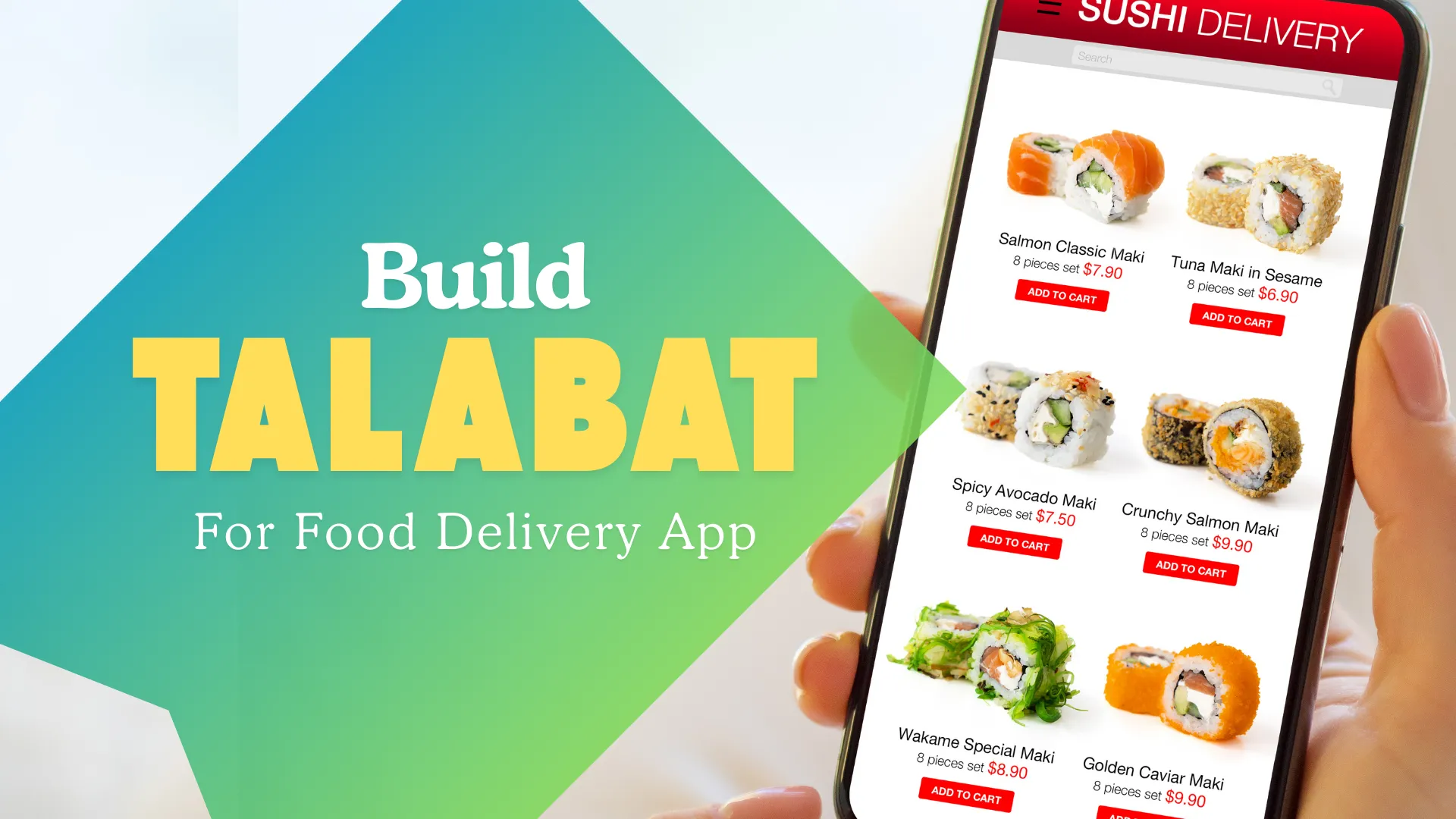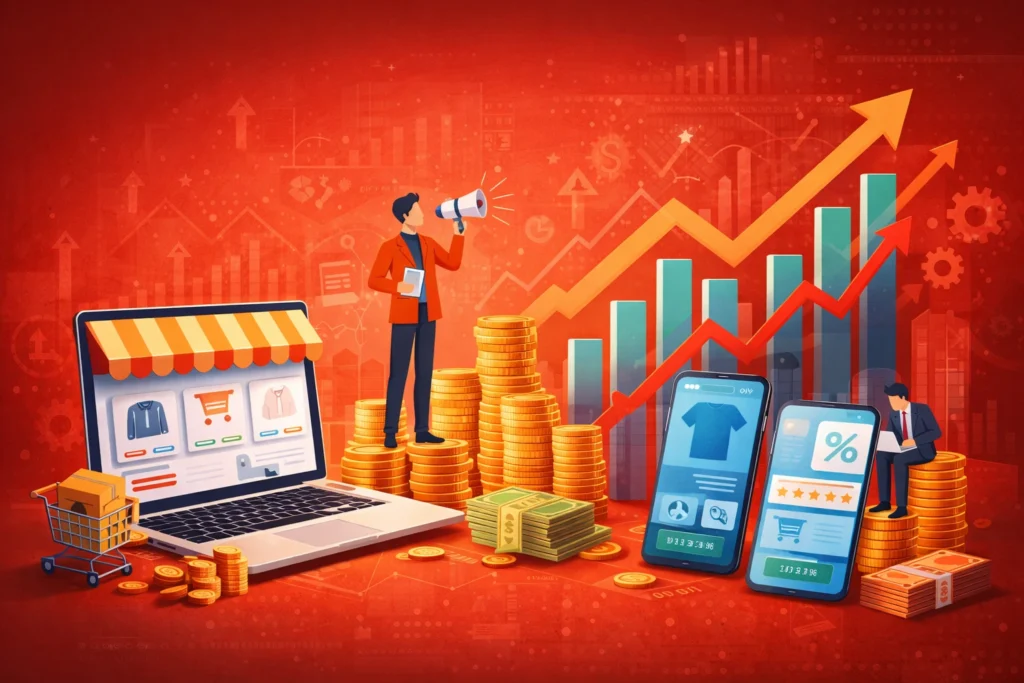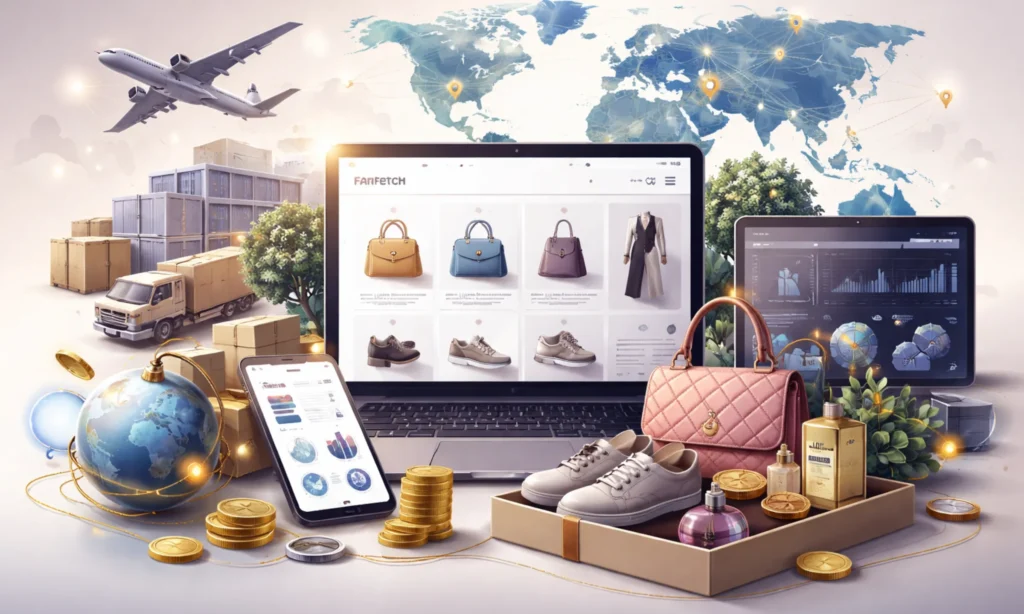In today’s fast-paced world, food delivery services have become a vital part of everyday life, making apps like Talabat indispensable for both consumers and businesses. Talabat, a leader in the Middle Eastern market, has revolutionized the way people order food, groceries, and more with just a few taps on their smartphones. Its easy-to-use interface, reliable delivery system, and diverse offerings make it a go-to app for millions of users.
For businesses, developing an app like Talabat presents a massive opportunity to tap into the growing demand for convenient, on-demand food delivery services. Whether you’re a startup or an established business, creating a food delivery app can drive significant revenue and customer engagement. But building such an app requires careful planning, the right technology, and an understanding of the market landscape.
In this guide, we will walk you through the essential steps, costs, and features needed to create an app like Talabat. With insights into the technical requirements, design, and development process, this comprehensive guide will equip you with everything you need to turn your app idea into reality. And if you’re looking for a reliable partner to bring your vision to life, Miracuves Solutions is here to provide expert guidance every step of the way.
What is Talabat and What Does It Do?
Talabat is a leading food delivery and grocery service app in the Middle East, offering users the ability to order meals, snacks, and essentials from local restaurants and stores right to their doorstep. Founded in Kuwait and now operational across various countries in the region, including the UAE, Saudi Arabia, and Qatar, Talabat has set the standard for fast, reliable, and diverse delivery services.
The app connects users with thousands of restaurants, grocery stores, and pharmacies, providing a seamless experience where customers can browse menus, place orders, and track deliveries in real time. Talabat operates through a network of partnered restaurants and delivery drivers, facilitating efficient service at any time of day. Its intuitive interface allows users to filter based on cuisine, ratings, and delivery time, giving them personalized choices in a user-friendly way.
For businesses, Talabat acts as a bridge to reach a broader audience, offering restaurants and stores a platform to enhance visibility and increase sales without the need for heavy infrastructure investment. It supports various payment methods, including cash on delivery and online payments, ensuring flexibility for all users.
Talabat’s impact on the region’s food delivery ecosystem has been profound, driving competition and encouraging innovation in the on-demand delivery space. Whether you’re looking to build a similar platform or improve an existing service, understanding how Talabat operates is crucial to making informed development choices.
Why Build an App Like Talabat?
Building an app like Talabat offers a golden opportunity to tap into the thriving on-demand delivery market. With the rapid growth of online food delivery services, consumers have grown accustomed to the convenience of ordering meals, groceries, and even medicines through mobile apps. This shift in consumer behavior has created a significant demand for businesses to offer digital solutions that cater to these needs. An app like Talabat not only meets these demands but also opens up new revenue streams for businesses.
The food delivery industry is projected to grow exponentially in the coming years. This growth is driven by urbanization, an increase in dual-income households, and a desire for convenience among consumers. For entrepreneurs and business owners, entering this market with a well-structured and feature-rich app offers the chance to generate consistent revenue through multiple business models. These include commission-based models, delivery fees, advertising, and even subscription services for premium features.
Moreover, having your own food delivery app can help you reach a wider audience, especially in regions where such services are still emerging or in high demand. With the right marketing strategies and a solid app foundation, businesses can quickly build a loyal customer base and expand their offerings beyond food to groceries, pharmacy deliveries, and more.
By developing an app like Talabat, you’re not just entering a profitable market but also creating a brand that provides essential services to customers at their convenience. It’s a smart investment for long-term success, especially if you focus on differentiation and unique value propositions.
Read more : – What is Blinkit App and How Does It Work?
How to Differentiate Your App from Competitors
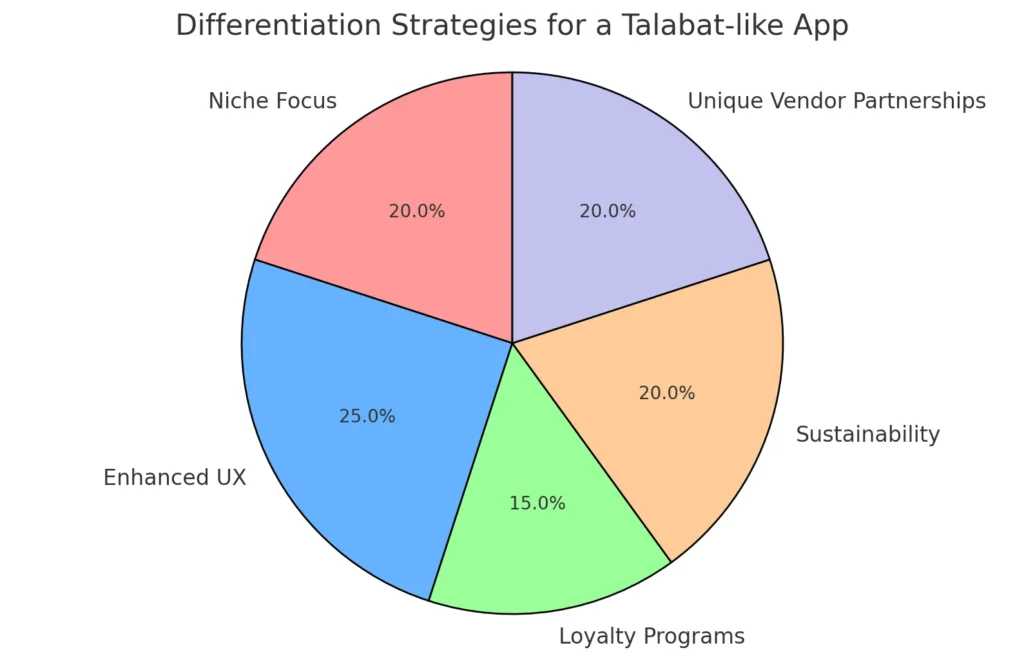
In a crowded marketplace of food delivery apps, differentiation is key to standing out and capturing user attention. While Talabat and other popular platforms dominate the space, there are several ways you can carve out a niche for your own app and make it more appealing to both users and business partners.
- Niche Focus: One way to stand out is by targeting a specific niche. For instance, instead of offering general food delivery services, you could focus on a specific type of cuisine, dietary preference (like vegan or organic food), or even fast, late-night deliveries. Specializing in a niche can help you attract a loyal customer base looking for something beyond what the big players offer.
- Enhanced User Experience (UX): Offering a smoother, more intuitive user experience can be a game-changer. Simple things like faster load times, personalized recommendations based on user preferences, or even voice-command features for placing orders can create a significant competitive edge.
- Loyalty Programs: Integrating rewards programs or loyalty points for frequent users is a great way to differentiate your app. You can offer users points for each order they place, which they can redeem for discounts or free deliveries, building long-term user engagement.
- Sustainability and Eco-Friendliness: A growing number of consumers are environmentally conscious and would prefer to support brands that reflect their values. Offering eco-friendly delivery options, like using electric bikes for deliveries, or promoting sustainable packaging can attract customers who care about the environment.
- Partnerships with Unique Vendors: Building exclusive partnerships with restaurants or local food vendors that are not available on other apps can give your platform an edge. Offering customers something they can’t find elsewhere is a great way to drive traffic and keep users engaged.
By focusing on these differentiation strategies, your app can offer a unique experience that goes beyond just food delivery. It’s about creating value that resonates with your target audience and keeps them coming back.
Market Size, Growth, and Business Model
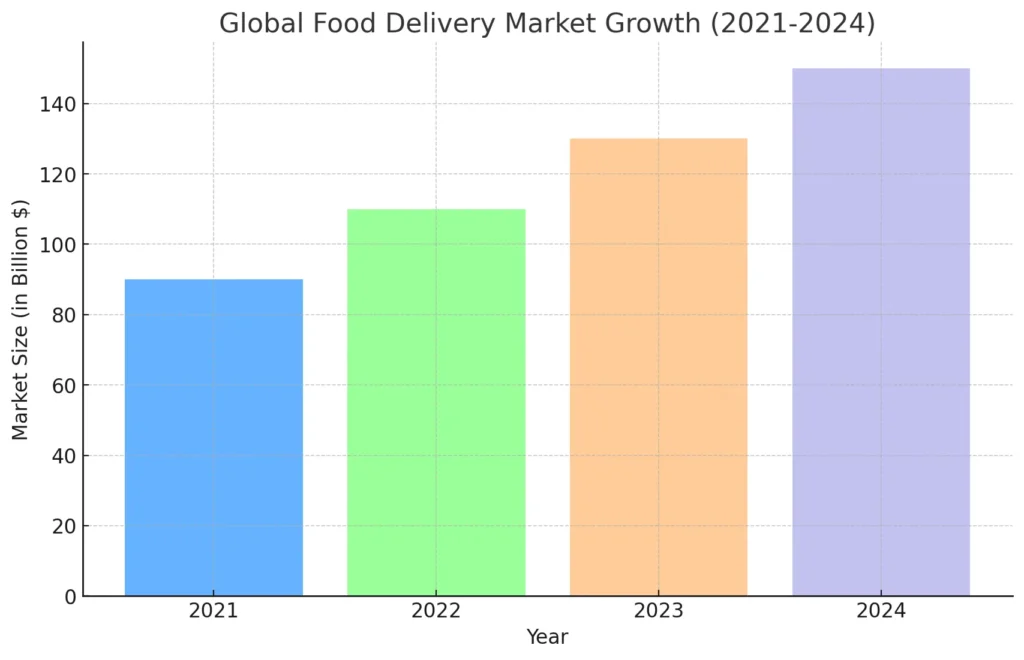
The food delivery market has been experiencing rapid growth over the last decade, driven by a mix of changing consumer behavior, technological advancements, and the convenience of mobile applications. According to current industry data, the global food delivery market is projected to exceed $150 billion in revenue by 2024, with continued expansion across regions like the Middle East, Asia, and North America. For businesses aiming to build an app like Talabat, this presents a lucrative opportunity to tap into a booming sector with massive potential for growth.
Market Growth: The demand for online food delivery services continues to rise as consumers seek quick, easy, and flexible dining options. This shift has been further accelerated by the global pandemic, where safety and convenience became top priorities. The Middle Eastern market, where Talabat thrives, is expected to grow significantly due to urbanization, an increase in disposable income, and a young, tech-savvy population.
Business Model Options: When developing an app like Talabat, you can choose from several revenue models:
- Commission-Based Model: The app charges a commission on every order processed, usually ranging between 15% to 30%, which is paid by the restaurants or vendors.
- Delivery Fee Model: Customers are charged a delivery fee for each order, providing a direct revenue stream for the app.
- Subscription Model: Users can subscribe to premium services that offer perks like free delivery or priority service.
- Advertising: Restaurants and vendors can pay for promotions or higher visibility within the app.
Each of these business models can be tailored based on your market and customer preferences, allowing for flexibility and scalability as your app grows. The key is to find the right balance between generating revenue and offering competitive pricing to keep users loyal to your platform.
Read More : B2B Marketplaces Explained: How They Work and the Top Examples You Need to Know
Key Features of an App Like Talabat
| Feature | Customers | Restaurants | Delivery Drivers |
|---|---|---|---|
| User Registration | Create a personal profile, save addresses, payment methods, and order history | Create restaurant profile, manage menu, pricing, and promotions | Sign up with driver information, vehicle details, and availability |
| Browse Listings/Orders | Search for restaurants by location, cuisine, or ratings | View incoming orders, manage order status | View available orders, accept deliveries based on location |
| Order Management | Place, track, and schedule orders | Manage orders in real time, update availability and stock | Accept and deliver orders efficiently using GPS navigation |
| Real-Time Tracking | Track delivery in real-time | Track order progress and communicate with drivers | Use GPS navigation for fast and accurate deliveries |
| Payment Options | Pay via card, mobile wallet, or cash on delivery | Accept payments through integrated systems, track transactions | Receive payments or tips directly from the app after deliveries |
| Ratings and Reviews | Rate restaurants and delivery services | Receive feedback from customers to improve services | Receive ratings based on delivery efficiency and customer interaction |
| Notifications | Receive order status updates and promotions | Get notified about incoming orders and customer feedback | Receive updates on available orders and delivery routes |
| In-App Support | Access live chat or help center for any issues | Communicate with customers and drivers, access support | Get support for delivery-related issues and payment concerns |
To build a successful food delivery app like Talabat, it’s crucial to integrate key features that provide convenience, functionality, and a seamless user experience. These features need to cater to all user groups—customers, restaurants, and delivery drivers—ensuring each party can navigate and use the app effectively.
Here are the core features that a Talabat-like app must include:
- User Registration and Profiles: Allow users (customers, restaurants, and delivery drivers) to sign up and create personalized profiles with relevant details like addresses, payment methods, and order history. This feature ensures smoother and quicker future transactions.
- Restaurant Listings: The app should provide a comprehensive list of restaurants, categorized by type, cuisine, location, and ratings. Users should be able to filter based on their preferences and access detailed menus for easy selection.
- Real-Time GPS Tracking: One of the standout features in apps like Talabat is real-time tracking, which allows users to follow the progress of their delivery from the restaurant to their doorstep. This feature also helps delivery drivers navigate routes efficiently.
- Multiple Payment Options: Offering users flexibility with payments is essential. Include multiple payment methods such as credit/debit cards, mobile wallets, and cash on delivery, catering to different user preferences.
- Push Notifications: Keeping users informed is key. Push notifications alert customers when their order is confirmed, being prepared, out for delivery, or when promotions and discounts are available.
- Order Scheduling: This feature allows customers to schedule their orders in advance, making the app more convenient for users who prefer to plan their meals or deliveries ahead of time.
- Ratings and Reviews: Allowing users to rate and review restaurants and delivery experiences helps build trust and credibility. This feature also guides new customers in making informed choices.
- In-App Support and Help Center: For customer satisfaction, it’s essential to have a built-in support system, such as a live chat feature or FAQs, ensuring users can resolve any issues quickly.
By incorporating these essential features, you can create a user-friendly, engaging, and efficient food delivery app that competes with major players like Talabat and delivers a smooth experience for all parties involved.
Minimum Viable Product (MVP) Approach
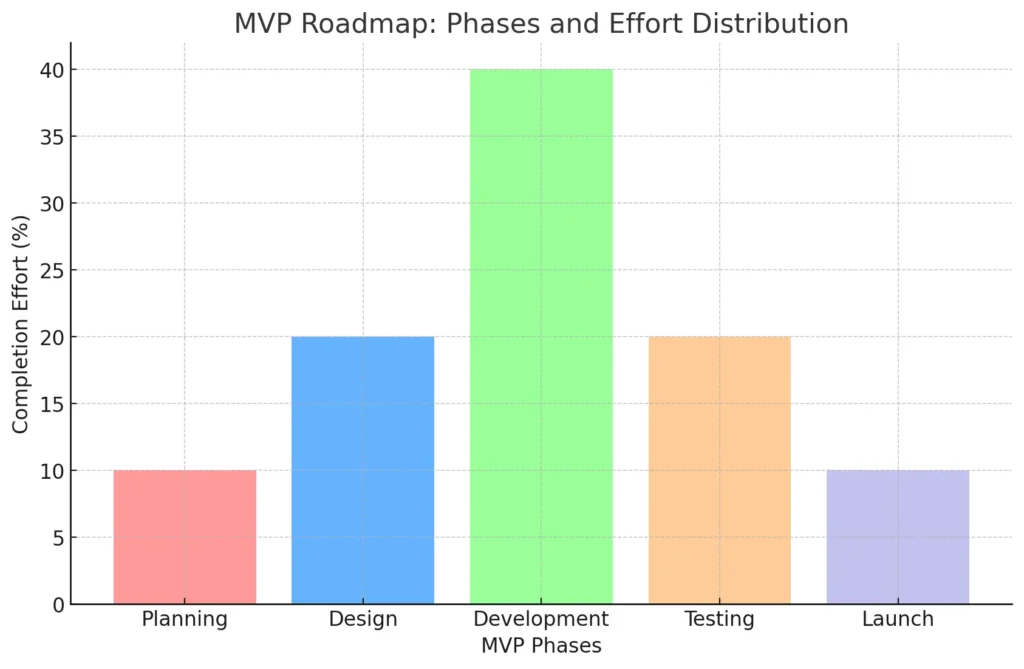
When building an app like Talabat, starting with a Minimum Viable Product (MVP) is one of the smartest strategies to ensure a successful launch. An MVP is a basic version of your app that includes only the essential features needed to meet user needs. The goal is to test the app with real users, gather feedback, and improve it incrementally without investing in a fully developed product from the start.
By launching an MVP, you can significantly reduce development time and costs while still entering the market quickly. It allows you to focus on the most critical features that solve the immediate problem for your users, rather than spending time and resources on additional features that may not be necessary at the start.
Key Features for an MVP in a Food Delivery App:
- User Registration and Login: Enable users (customers, restaurants, and drivers) to create and manage accounts.
- Restaurant Listings and Menus: Basic functionality that allows customers to browse available restaurants and view menus.
- Order Placement: Simple order placement for customers, with notifications sent to restaurants for order fulfillment.
- Real-Time GPS Tracking: Basic tracking that shows customers where their order is and allows drivers to navigate to the delivery location.
- Payment Integration: Secure and easy payment options, such as card payments or mobile wallets, to complete orders.
- Order History: Users should be able to see past orders, helping with convenience and repeat orders.
These are the essential features that form the core of any food delivery app. Once the MVP is live, you can collect data on how users interact with your app, which features they value the most, and what needs improvement. This iterative process ensures that you’re only investing in features that truly enhance the user experience and business performance.
Building an MVP doesn’t just save time and money; it also lowers the risk of launching a product that doesn’t meet market expectations. With constant feedback loops, your app can evolve based on real-world usage, making it easier to scale and improve over time.
Technical Requirements
| Component | Technology Options | Purpose |
|---|---|---|
| Frontend Technologies | React Native, Flutter | Cross-platform app development for iOS and Android |
| Backend Technologies | Node.js, Python (Django/Flask) | Server-side development, handling data and real-time updates |
| Databases | MongoDB, PostgreSQL | Storing user data, order information, restaurant details |
| APIs | Google Maps API, Stripe, PayPal, Firebase Cloud Messaging | Location services, secure payments, and push notifications |
| Cloud Hosting | AWS (Amazon Web Services), Google Cloud | Scalable server infrastructure for handling traffic |
| Security | SSL encryption, OAuth, PCI DSS compliance | Ensuring data protection and secure payment processing |
| Real-Time Notifications | Firebase Cloud Messaging (FCM) | Sending push notifications for real-time updates |
Building a robust, scalable app like Talabat requires careful consideration of the technical stack. The app needs to handle real-time data processing, secure payment transactions, seamless user interactions, and smooth backend operations, all while maintaining high performance. Here’s an overview of the essential technologies and tools you’ll need to create an app like Talabat:
- Frontend Technologies: The frontend of the app is what users interact with. For cross-platform development (iOS and Android), popular frameworks like React Native or Flutter are ideal. These frameworks allow developers to write code once and deploy it across multiple platforms, reducing development time and costs.
- Backend Technologies: The backend is the engine that powers the app. Technologies like Node.js or Python (Django/Flask) are widely used for building scalable, real-time applications. These frameworks offer great flexibility and are known for handling large volumes of traffic and data efficiently.
- Databases: To store user data, restaurant details, menus, and order information, databases like MongoDB or PostgreSQL are preferred for their speed and scalability. NoSQL databases like MongoDB are particularly good at handling real-time data and scaling as the app grows.
- APIs: Integration with third-party APIs is essential for features like payment gateways (e.g., Stripe, PayPal), location services (e.g., Google Maps API for real-time tracking), and push notifications. These APIs help in providing seamless services like live tracking and secure payments.
- Cloud Hosting: For hosting the app, cloud platforms like AWS (Amazon Web Services) or Google Cloud are highly recommended. These platforms provide scalable server infrastructure, ensuring that your app can handle increased traffic as your user base grows.
- Security: Given that your app will be processing sensitive data, such as payment information and personal user details, implementing strong security measures is crucial. SSL encryption, OAuth for secure login, and PCI DSS compliance for payment processing are some of the key security measures required.
- Real-Time Notifications: For real-time updates on order status, in-app notifications, and delivery tracking, using tools like Firebase Cloud Messaging (FCM) will allow you to send push notifications efficiently to users and delivery drivers.
By selecting the right combination of technologies, you can ensure that your app is not only functional but also highly scalable and secure. These technical foundations are critical to delivering a smooth user experience, especially in an industry where speed and reliability are key.
Design and User Interface (UI/UX)
A well-designed user interface (UI) and seamless user experience (UX) are crucial to the success of any app, especially in the highly competitive food delivery space. When developing an app like Talabat, it’s important to focus on design elements that are not only visually appealing but also intuitive and functional. The goal is to make the app easy to navigate for all user types—customers, restaurant owners, and delivery drivers.
1. Simple and Intuitive Navigation
One of the key factors in a successful food delivery app is simplicity. Users should be able to browse through restaurants, view menus, and place orders with minimal effort. Clear, concise labels, easy-to-find buttons, and a streamlined layout help users find what they need quickly. For delivery drivers and restaurant managers, the interface should provide a straightforward dashboard to manage orders and track deliveries.
2. Responsive and Adaptive Design
Since users will access the app from different devices—smartphones, tablets, and even desktops—it’s important that the design is fully responsive. This means ensuring that the app layout adjusts automatically to different screen sizes without sacrificing usability or aesthetics. A mobile-first design approach is recommended, as most users will interact with the app on their phones.
3. Personalization and User Preferences
Personalization is key to improving user retention. Features like saving favorite restaurants, offering meal recommendations based on order history, and personalized deals create a more tailored experience. A design that adapts to user preferences makes the app feel more relevant and engaging.
4. High-Quality Visuals and Minimalist Design
While functionality is the backbone of a good app, visual appeal also plays a major role. High-quality images of dishes, restaurants, and branding elements enhance the user experience. However, a minimalist design approach, with plenty of white space and uncluttered layouts, ensures that the visuals don’t overwhelm the user.
5. Fast Loading Times and Performance
Users expect apps to load quickly and perform without glitches. Optimizing UI design to ensure that content and images load smoothly will prevent users from abandoning the app. Keeping the design light and optimized for performance is crucial to retaining users in the long run.
6. Accessibility Features
Finally, incorporating accessibility features like larger text options, voice commands, or support for screen readers can make the app usable by a wider audience, including those with disabilities.
An intuitive, visually pleasing, and user-friendly design can significantly boost user engagement and retention, making your food delivery app a go-to option for customers.
Development Process
The development process for building an app like Talabat requires careful planning, a well-structured roadmap, and a skilled team to bring the idea to life. Here’s a breakdown of the essential stages involved in developing a food delivery app from start to finish:
1. Idea Validation and Market Research
Before jumping into the development phase, it’s important to validate your app idea. Conduct thorough market research to understand your target audience, study your competitors, and identify gaps in the market. This ensures that your app solves real problems and stands out in the crowded food delivery space.
2. Wireframing and Prototyping
Once the idea is validated, the next step is to design a wireframe or prototype. Wireframing helps in visualizing the app’s structure, layout, and navigation flow without focusing on the final design. Using tools like Figma or Sketch, you can create low-fidelity wireframes and get feedback from stakeholders before moving forward.
3. Frontend and Backend Development
This is the core stage of app development, where the design is translated into a fully functional app. The frontend development focuses on creating the user interface and ensuring a smooth user experience. This includes building the screens, buttons, and interactive elements of the app.
The backend development involves setting up the server, database, and APIs that power the app. It ensures that the app can handle data storage, user authentication, and order management. Technologies like Node.js or Python for backend and React Native or Flutter for frontend are often used to build scalable, responsive apps.
4. Integration of Key Features
During development, it’s essential to integrate core features like:
- Real-time GPS tracking
- Multiple payment gateways
- Push notifications
- Restaurant and menu management
- Order history and status updates
These features ensure the app delivers the seamless functionality users expect from a food delivery platform.
5. Testing and Quality Assurance (QA)
Once the development phase is complete, the app needs to undergo rigorous testing to ensure it’s bug-free and ready for launch. Unit testing, integration testing, and user acceptance testing (UAT) are conducted to catch any issues before the app goes live. Testing should focus on the app’s performance, security, and usability.
6. Deployment and Launch
After successful testing, the app is ready for deployment. The app can be submitted to app stores (Apple App Store, Google Play Store) following the respective guidelines. At this stage, it’s important to ensure that the app store optimization (ASO) is done right to increase visibility and downloads.
7. Post-Launch Support and Updates
The development process doesn’t stop at the launch. After the app goes live, continuous monitoring and maintenance are necessary to ensure its smooth operation. User feedback can provide insights into areas for improvement or additional features. Regular updates based on this feedback keep the app relevant and engaging.
By following these stages, you can ensure a smooth development process that leads to a functional, user-friendly app that meets the needs of both customers and businesses.of both customers and businesses.
Read Also : Creating Your Own Grubhub Clone: Key Features and Development Steps
Cost Estimation and Timeframe
| App Complexity | Features Included | Estimated Cost | Development Time |
|---|---|---|---|
| Basic App | User registration, restaurant listings, basic order system, payment gateway integration | $30,000 – $50,000 | 3 to 6 months |
| Medium Complexity App | All basic features plus real-time GPS tracking, push notifications, advanced user interface | $50,000 – $80,000 | 6 to 9 months |
| Advanced App | All medium features plus loyalty programs, AI-driven recommendations, multi-language support | $100,000 and above | 9 to 12 months or longer |
Building an app like Talabat requires a strategic approach to budgeting and timelines. The cost of developing such an app depends on several factors, including the complexity of the features, the size of the development team, and whether you choose to develop in-house or outsource to a development agency.
1. Key Factors Affecting Cost
- App Features: The more complex the features, the higher the cost. Basic features like user registration, restaurant listings, and payment gateways are standard, but adding advanced features like real-time tracking, loyalty programs, and AI-powered recommendations can significantly increase the cost.
- Design and User Interface (UI/UX): High-quality design, with a focus on user experience, often requires more time and resources. If you want a premium, well-optimized app, investing in a top-notch design is essential.
- Platform: Developing for both iOS and Android will naturally increase costs compared to developing for a single platform.
- Development Team: The cost of hiring developers varies based on location and expertise. Outsourcing to regions like Eastern Europe or South Asia can reduce costs compared to hiring developers in Western Europe or the US. Additionally, a full-cycle development team, including frontend, backend, design, and QA specialists, will have higher costs but will ensure smoother app development.
- Post-Launch Maintenance: The initial development is not the only expense. Ongoing updates, bug fixes, and adding new features will also require a portion of the budget.
2. Estimated Development Costs
On average, developing an app like Talabat can cost anywhere between $30,000 to $100,000. This estimation includes basic functionality like user accounts, restaurant management, and payment systems. However, adding more advanced features like real-time GPS tracking, AI-driven suggestions, and multi-language support can push the cost upwards of $150,000 or more.
For example:
- Basic App: $30,000 – $50,000
- Medium Complexity App: $50,000 – $80,000
- Advanced App with Full Features: $100,000 and above
3. Timeframe
The timeline for developing a food delivery app like Talabat depends on its complexity:
- Basic App: 3 to 6 months
- Medium Complexity App: 6 to 9 months
- Advanced App: 9 to 12 months or longer
These timelines include stages such as planning, design, development, testing, and deployment. To expedite the process, you can choose to launch an MVP (Minimum Viable Product) within a shorter timeframe, then gradually roll out advanced features.
Why Trust Miracuves Solutions for Your Project?
Miracuves Solutions offers cost-efficient, high-quality app development services tailored to your needs. With expertise in delivering projects on time and within budget, Miracuves Solutions can help you transform your app idea into a reality, providing end-to-end support from planning to post-launch maintenance.
Ready to create your own food delivery app like Talabat?
We specialize in building scalable platforms with features
such as easy order placement, multiple payment options, and real-time delivery updates.
Monetization Strategies
Once you’ve built a food delivery app like Talabat, it’s important to focus on how the app will generate revenue. The right monetization strategies can help ensure long-term profitability while keeping the user experience smooth and enjoyable. Here are the key monetization methods commonly used by food delivery apps:
1. Commission on Orders
One of the most popular revenue models for food delivery apps is charging a commission on each order placed through the platform. Typically, restaurants pay a percentage of each sale (usually between 15% to 30%) to the app for using its platform to reach customers. This model is effective because it creates a win-win situation: restaurants get more orders, and the app gets a steady revenue stream.
2. Delivery Fees
Another way to generate revenue is by charging customers a delivery fee. This fee can vary depending on factors like distance, delivery time, or order value. Some apps offer customers free delivery for orders above a certain amount or as part of a loyalty program. Delivery fees are a direct way to boost revenue while covering the operational costs of managing delivery drivers.
3. Subscription Model
Offering a subscription model for premium users can be a great way to build loyalty and provide added value. For example, customers can pay a monthly or yearly fee to enjoy perks like free deliveries, priority customer service, or exclusive deals. This helps create a consistent revenue stream and encourages regular app usage.
4. Advertising and Promotions
Restaurants and brands can pay for in-app advertising or promotions to increase their visibility. This includes featured listings, banner ads, or placing restaurants at the top of search results within the app. Advertising allows restaurants to gain more exposure while providing the app with additional revenue.
5. Partnering with Grocery Stores and Pharmacies
Many food delivery apps, including Talabat, have expanded their services to include grocery and pharmacy deliveries. Partnering with these businesses can open up new revenue streams, as the app can charge fees for delivering a wider range of products. Offering additional services makes the app more valuable to users and increases the frequency of orders.
6. In-App Purchases and Add-Ons
Offering users the ability to purchase add-ons, such as extra toppings, beverages, or side dishes, can be another revenue source. This method not only increases the average order value but also enhances the user experience by giving customers more options.
By implementing a combination of these monetization strategies, you can maximize the profitability of your app while providing valuable services to users and restaurant partners. The key is to strike a balance between generating revenue and maintaining a user-friendly experience that keeps customers returning to the platform.
Launching and Marketing the App
Once your food delivery app is ready, the next step is to launch it and attract users to your platform. A well-planned launch combined with an effective marketing strategy can set the foundation for long-term success. Here are some key steps to ensure a successful launch and ongoing user acquisition:
1. Pre-Launch Preparation
Before the official launch, build excitement by creating a pre-launch marketing campaign. This could involve setting up a landing page where users can sign up for early access or exclusive discounts. Use social media channels to tease features, showcase your app’s unique selling points, and generate buzz. Building anticipation before the app becomes available helps ensure a strong initial user base.
2. App Store Optimization (ASO)
Optimizing your app for the app stores (Apple App Store and Google Play Store) is crucial to ensure it gets discovered by potential users. Focus on the following elements:
- App Title and Keywords: Include relevant keywords in the app title and description to improve searchability.
- App Icon and Screenshots: Use visually appealing icons and screenshots that showcase your app’s features and design. This helps users understand the app’s value at a glance.
- App Reviews and Ratings: Encourage early users to leave positive reviews, as these play a significant role in app store rankings and downloads.
3. Social Media Marketing
Leverage social media platforms like Instagram, Facebook, and Twitter to promote your app. Share engaging content, such as user-generated posts, behind-the-scenes development stories, and exclusive offers for followers. Collaborate with influencers or food bloggers to spread the word and create credibility for your brand. Social media advertising can also target specific demographics, helping you reach your ideal user base more effectively.
4. Paid Advertising
To accelerate user acquisition, consider investing in paid ads on platforms like Google Ads, Facebook Ads, and Instagram. These ads allow you to reach users based on their interests, location, and behavior, ensuring your marketing efforts are targeted to people most likely to use your app. Paid advertising works well during the initial launch phase to create awareness and drive downloads.
5. Referral Programs
A referral program can be a powerful tool for organic growth. Encourage existing users to refer new customers by offering them incentives, such as discounts on their next order. For every new user that signs up using their referral code, both the referrer and the new user can receive rewards, helping to spread the app quickly through word of mouth.
6. Partner with Local Restaurants and Brands
Partnering with local restaurants, grocery stores, or well-known brands can provide mutual benefits. Restaurants get increased exposure, and your app benefits from being associated with reputable businesses. Hosting joint promotions, such as special deals or exclusive offers, can attract a wider audience and drive more orders.
7. Email Marketing Campaigns
Email marketing is an effective way to re-engage users who have signed up or downloaded the app but haven’t placed an order yet. Sending personalized emails with special promotions, order updates, or reminders about favorite restaurants can encourage users to return to the app and make a purchase.
By combining these strategies, you can ensure a successful app launch and build a loyal customer base. The key is consistency in your marketing efforts, focusing on both online and offline tactics to increase brand awareness and drive app downloads.
Read more : – Business Model of Grubhub: How Grubhub Makes Money Delivering Food Fast
Legal and Regulatory Considerations
When developing a food delivery app like Talabat, it’s essential to navigate the legal and regulatory landscape carefully. Failure to comply with relevant laws can lead to hefty fines, operational delays, or even the shutdown of your app. Understanding the regulatory requirements in the regions where you plan to operate ensures a smooth launch and avoids legal complications. Here are some of the critical legal aspects to consider:
1. Data Privacy and Protection
With users sharing sensitive information like personal addresses, payment details, and order histories, data protection is paramount. Compliance with data protection regulations such as GDPR (General Data Protection Regulation) in Europe or CCPA (California Consumer Privacy Act) in the US is crucial. These regulations govern how businesses collect, store, and manage user data.
Ensure that your app:
- Has a clear privacy policy outlining how user data is handled.
- Implements SSL encryption for secure transmission of data.
- Offers users the ability to manage their personal data, including the right to delete their information if requested.
2. Payment Compliance
Since your app will process payments for food orders, you need to ensure that your payment systems comply with PCI DSS (Payment Card Industry Data Security Standard) regulations. This ensures that users’ payment details are processed securely, protecting them from fraud and theft.
To maintain compliance, make sure:
- Payment gateways are PCI DSS certified.
- Secure payment methods like tokenization and encryption are implemented.
3. Local Food Delivery Regulations
Depending on the region where your app operates, there may be specific regulations governing the delivery of food. For example:
- Health and safety standards: Restaurants partnering with your app should comply with local health regulations, ensuring that food is prepared and delivered safely.
- Delivery permits: Delivery drivers may need permits to operate, especially in large cities. Some regions may require drivers to have special insurance for commercial delivery.
Your app must have clear guidelines for partnering restaurants and drivers to ensure they meet these regulatory requirements. You may also need to implement agreements that outline these responsibilities.
4. Contracts with Restaurants and Delivery Drivers
When partnering with restaurants and independent delivery drivers, you need to establish legally binding contracts that define each party’s responsibilities. These agreements should cover aspects such as:
- Commission rates paid to your app by restaurants.
- Driver compensation and terms of service, including any tips and additional fees.
- Liability clauses in case of delays, incorrect orders, or damages.
Clear contracts help protect both your business and your partners while setting expectations.
5. Tax Compliance
Handling payments from customers and distributing payments to restaurants and delivery drivers means your app will also need to comply with local tax regulations. This may involve charging VAT or sales tax on orders and ensuring that businesses using your platform are also tax compliant.
To manage tax compliance efficiently:
- Integrate an automated tax calculation system based on the customer’s location.
- Ensure that restaurants are responsible for reporting their earnings and taxes, as specified in their contracts.
By addressing these legal and regulatory considerations during the development process, you can avoid costly legal issues, build trust with users, and ensure that your app operates smoothly in any region.
Future Growth
As the food delivery industry continues to expand, there are several strategies you can implement to ensure your app scales effectively and remains competitive in the long run. The key to future growth lies in continuous innovation, understanding customer behavior, and adapting to changing market trends. Here are some ways to ensure the long-term success of your food delivery app:
1. Expanding to New Markets
Once your app has gained traction in its initial market, one of the most effective ways to grow is by expanding to new geographic locations. Focus on regions with rising demand for food delivery services, particularly areas with a growing population of tech-savvy users and urban centers where convenience is a priority. Researching market trends, understanding local regulations, and forming partnerships with restaurants in new regions will be essential for successful expansion.
2. Adding New Services
To keep your app relevant and engaging, consider expanding the types of services you offer. Many successful food delivery platforms have added services beyond food, such as:
- Grocery Delivery: Partnering with local supermarkets to offer grocery delivery options.
- Pharmacy Delivery: Providing a way for users to order medications and health products.
- Package Delivery: Expanding into last-mile logistics by offering package or courier delivery services for businesses.
Diversifying your app’s offerings will attract new users and increase the frequency of orders from existing customers.
3. Integrating Advanced Technologies
Incorporating emerging technologies can give your app a competitive edge. Consider these innovations:
- Artificial Intelligence (AI): Using AI to improve delivery routes, personalize restaurant recommendations, and analyze user behavior for better marketing strategies.
- Machine Learning: Machine learning algorithms can help optimize delivery times, predict order trends, and enhance user experiences through smart suggestions.
- Augmented Reality (AR): While not yet widespread in food delivery, AR can be used for interactive promotions or giving users a virtual look at their food before ordering.
Investing in these technologies can lead to improved efficiency and customer satisfaction.
4. Loyalty Programs and Subscriptions
Retaining customers is often more cost-effective than acquiring new ones. Implementing loyalty programs that reward users for frequent orders is a proven way to build a loyal customer base. You can offer discounts, free delivery, or points that can be redeemed for future orders. Additionally, subscription models (similar to Uber Eats Pass) can provide regular users with perks like free delivery or exclusive deals for a monthly or yearly fee.
5. Data-Driven Decision Making
As your app grows, the data collected from user interactions, order patterns, and delivery trends becomes a valuable asset. Using data analytics, you can make informed decisions to enhance customer experiences, optimize delivery operations, and develop targeted marketing strategies. Tracking user preferences allows you to personalize their experiences, making them more likely to return.
6. Sustainability and Eco-Friendly Practices
With growing consumer awareness around environmental impact, offering eco-friendly delivery options can set your app apart. Consider initiatives such as:
- Partnering with restaurants that use sustainable packaging.
- Encouraging carbon-neutral deliveries by using electric bikes or scooters.
- Offering users the option to contribute to environmental causes with their orders.
These initiatives not only appeal to environmentally conscious users but also reflect positively on your brand’s image.
By focusing on expansion, service diversification, and customer retention, you can ensure that your app continues to grow and adapt to the evolving market. Staying innovative and responsive to trends is the key to long-term success.
Why Trust Miracuves Solutions for Your Next Project?
When it comes to building a complex and feature-rich app like Talabat, you need a development partner you can trust. Miracuves Solutions is a leading name in the field of app development, known for delivering high-quality, scalable, and customized solutions that meet the unique needs of your business. Here’s why Miracuves Solutions stands out as the ideal choice for your next project:
1. Proven Expertise
With years of experience in the app development industry, Miracuves Solutions has a track record of creating successful apps across various industries, including food delivery, e-commerce, and logistics. Our team of skilled developers, designers, and project managers are well-versed in the latest technologies and industry trends, ensuring your app is built to the highest standards.
2. End-to-End Development Services
Miracuves Solutions offers a complete range of development services—from concept and strategy to design, development, and post-launch support. Whether you need an MVP to test your idea or a fully-fledged app with advanced features, we handle every step of the process. Our holistic approach ensures that your project is executed seamlessly and delivered on time.
3. Custom Solutions Tailored to Your Business
No two businesses are the same, and we understand that your app should reflect the specific needs of your market and target audience. At Miracuves Solutions, we work closely with you to understand your goals and provide tailored solutions that align with your vision. From unique design elements to advanced features, we customize every aspect of the app to help your business stand out.
4. Focus on Scalability and Growth
As your business grows, your app will need to scale to accommodate more users, transactions, and services. Miracuves Solutions ensures that your app is built with scalability in mind, allowing for seamless expansion into new markets or the addition of new features. This future-proof approach helps you avoid costly redevelopment down the road.
5. Ongoing Support and Maintenance
Our relationship with clients doesn’t end at launch. We provide ongoing support and maintenance to ensure that your app remains up-to-date, secure, and performing at its best. Whether you need bug fixes, updates, or new features added, our dedicated support team is always available to assist you.
6. Cost-Efficient Solutions
We believe that high-quality app development doesn’t have to come with a hefty price tag. Miracuves Solutions offers competitive pricing and flexible packages designed to fit your budget without compromising on quality. We work efficiently to ensure that your app is delivered on time and within budget.
By choosing Miracuves Solutions, you are partnering with a team that is as committed to your success as you are. Our proven expertise, custom approach, and dedication to quality make us the perfect partner to bring your app idea to life.
Conclusion
Building a food delivery app like Talabat presents a massive opportunity in today’s digital world. With the food delivery market projected to grow rapidly, now is the perfect time to invest in developing an app that caters to the increasing demand for convenience and on-demand services. By focusing on essential features, a user-friendly design, and the right technology stack, your app can offer a seamless experience to customers, restaurants, and delivery drivers alike.
Creating a well-thought-out app, combined with a strategic launch and marketing plan, will give your business the competitive edge needed to succeed in this fast-growing industry. Whether you’re a startup looking to break into the market or an established business expanding your services, a solid development strategy is crucial.
To ensure success, it’s important to work with the right development partner. Miracuves Solution has the expertise, experience, and commitment to help you bring your app vision to life, offering tailored solutions, reliable support, and cost-effective services to meet your business needs.
The road to building a successful app is challenging, but with careful planning and execution, you can create a platform that not only meets market demand but thrives in it. Start your journey today, and build the next big app in the food delivery space.
Want to see how a food delivery app works?
Explore how our platform integrates essential features like restaurant listings, order tracking, and payment solutions—just like Talabat.
FAQs
How much does it cost to create an app like Talabat?
The cost to develop an app like Talabat can range from $30,000 to over $150,000, depending on the app’s complexity, features, and the development team’s location. Basic apps cost less, while advanced apps with additional features will require a larger budget.
How long does it take to build a food delivery app?
Building a food delivery app typically takes between 3 to 12 months. The timeframe depends on the complexity of the app, the development process, and whether you’re building a basic app or one with advanced features like real-time tracking or AI integration.
What technologies are needed to build a food delivery app?
You’ll need a combination of frontend and backend technologies, such as React Native or Flutter for the frontend and Node.js or Python for the backend. Additional tools like Google Maps API for tracking and Stripe or PayPal for payments are also essential.
What features are necessary for a successful food delivery app?
Key features include user registration, restaurant listings, real-time GPS tracking, multiple payment options, and order history. These ensure a seamless and user-friendly experience for customers, restaurants, and drivers.
How can I make my app stand out in the competitive food delivery market?
To differentiate your app, focus on offering unique features like loyalty programs, niche delivery services, and eco-friendly options. Personalization, advanced tech like AI, and partnerships with exclusive vendors can also help your app stand out.
Related Articles:
- How To Build a Food Delivery App Like Baemin: Features, Costs, and Development
- How to Build an App Like Blinkit: A Developer’s Guide to Fast-Growth Grocery Delivery Apps
- Most Profitable Grocery Delivery Apps to Launch
- Step-by-Step Process to Build a Telehealth App Like Maple
- Developing a Mental Health App Like BetterHelp: Costs, Features, and More



